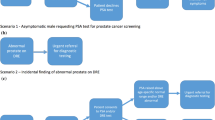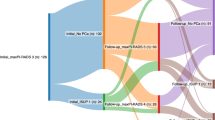Abstract
Background
Seminal vesicle invasion (SVI) is associated with adverse clinical outcomes in prostate cancer (PCa) patients. Despite its anatomical similarity and close proximity to the seminal vesicle, the prognostic significance of vas deferens invasion (VDI) by PCa has not been elucidated. For these reasons, we investigated the impact of VDI on the oncological outcome of pT3b PCa in association with SVI.
Methods
We retrospectively reviewed the medical records of 3359 patients who had undergone a radical prostatectomy at our institution between January 2000 and December 2014 for PCa. Patients who received neoadjuvant or adjuvant treatment (radiation, androgen deprivation therapy, or both) and those without adequate medical records were excluded. A Kaplan–Meier analysis was performed to analyze biochemical recurrence-free survival (BCRFS), and a Cox regression model was used to test the influence of VDI on biochemical recurrence (BCR).
Results
Of 350 patients with pathologically confirmed SVI (pT3b), 87 (24.9%) had VDI, while the remaining 263 patients (75.1%) had isolated SVI. Compared with SVI patients without VDI, SVI patients with VDI were noted to have a significantly worse 5-year BCRFS (25.1 vs. 17.1%, respectively). VDI was a significant predictor of BCR in multivariate Cox regression analysis (hazard ratio 1.39, 95% confidence interval 1.02–1.90; p = 0.039).
Conclusions
Our results shows that the prognosis of PCa with SVI might be further stratified by VDI status, thus suggesting the role of VDI either as a surrogate for poor prognosis or as a determinant for adjuvant therapy.


Similar content being viewed by others
References
Potter SR, Epstein JI, Partin AW. Seminal vesicle invasion by prostate cancer: prognostic significance and therapeutic implications. Rev Urol. 2000;2:190–5.
Ohori M, Scardino PT, Lapin SL, Seale-Hawkins C, Link J, Wheeler TM. The mechanisms and prognostic significance of seminal vesicle involvement by prostate cancer. Am J Surg Pathol. 1993;17:1252–61.
Villers AA, McNeal JE, Redwine EA, Freiha FS, Stamey TA. Pathogenesis and biological significance of seminal vesicle invasion in prostatic adenocarcinoma. J Urol. 1990;143:1183–7.
Yigit N, Karslioglu Y, Kurt B. Vas deferens invasion: a neglected issue in the sampling of radical prostatectomy materials. Can Urol Assoc J. 2014;8:E554–7.
Berney DM, Wheeler TM, Grignon DJ, et al. International Society of Urological Pathology (ISUP) consensus conference on handling and staging of radical prostatectomy specimens. Working group 4: seminal vesicles and lymph nodes. Mod Pathol. 2011;24:39–47.
Saar M, Kamradt J, Sauer C, Stockle M, Grobholz R. Margin status of the vas deferens in radical prostatectomy specimens: relevant or waste of time? Histopathology. 2014;65:45–50.
Zakian KL, Hatfield W, Aras O, et al. Prostate MRSI predicts outcome in radical prostatectomy patients. Magn Reson Imaging. 2016;34:674–81.
Koo KC, Tuliao P, Komninos C, et al. Prognostic impact of time to undetectable prostate-specific antigen in patients with positive surgical margins following radical prostatectomy. Ann Surg Oncol. 2015;22:693–700.
Huang CC, Deng FM, Kong MX, Ren Q, Melamed J, Zhou M. Re-evaluating the concept of “dominant/index tumor nodule” in multifocal prostate cancer. Virchows Arch. 2014;464:589–94.
Chen ME, Johnston DA, Tang K, Babaian RJ, Troncoso P. Detailed mapping of prostate carcinoma foci: biopsy strategy implications. Cancer. 2000;89:1800–9.
Cronin AM, Godoy G, Vickers AJ. Definition of biochemical recurrence after radical prostatectomy does not substantially impact prognostic factor estimates. J Urol. 2010;183:984–9.
Freedland SJ, Aronson WJ, Presti JC, Jr., et al. Predictors of prostate-specific antigen progression among men with seminal vesicle invasion at the time of radical prostatectomy. Cancer. 2004;100:1633–8.
Salomon L, Anastasiadis AG, Johnson CW, et al. Seminal vesicle involvement after radical prostatectomy: predicting risk factors for progression. Urology. 2003;62:304–9.
Debras B, Guillonneau B, Bougaran J, Chambon E, Vallancien G. Prognostic significance of seminal vesicle invasion on the radical prostatectomy specimen. Rationale for seminal vesicle biopsies. Eur Urol. 1998;33:271–7.
Srigley JR, Humphrey PA, Amin MB, et al. Protocol for the examination of specimens from patients with carcinoma of the prostate gland. Arch Pathol Lab Med. 2009;133:1568–76.
Epstein JI, Partin AW, Potter SR, Walsh PC. Adenocarcinoma of the prostate invading the seminal vesicle: prognostic stratification based on pathologic parameters. Urology. 2000;56:283–8.
Billis A, Teixeira DA, Stelini RF, Quintal MM, Guimaraes MS, Ferreira U. Seminal vesicle invasion in radical prostatectomies: which is the most common route of invasion? Int Urol Nephrol. 2007;39:1097–102.
Nguyen DP, Giannarini G, Seiler R, et al. Local recurrence after retropubic radical prostatectomy for prostate cancer does not exclusively occur at the anastomotic site. BJU Int. 2013;112:E243–9.
Kristiansen A, Wiklund F, Wiklund P, Egevad L. Prognostic significance of patterns of seminal vesicle invasion in prostate cancer. Histopathology. 2013;62:1049–56.
Bottke D, Bartkowiak D, Schrader M, Wiegel T. Radiotherapy after radical prostatectomy: immediate or early delayed? Strahlenther Onkol. 2012;188:1096–101.
Thompson IM, Tangen CM, Paradelo J, et al. Adjuvant radiotherapy for pathological T3N0M0 prostate cancer significantly reduces risk of metastases and improves survival: long-term followup of a randomized clinical trial. J Urol. 2009;181:956–62.
Heidenreich A, Bellmunt J, Bolla M, et al. EAU guidelines on prostate cancer. Part 1: screening, diagnosis, and treatment of clinically localised disease. Eur Urol. 2011;59:61–71.
Bolla M, van Poppel H, Collette L, et al. Postoperative radiotherapy after radical prostatectomy: a randomised controlled trial (EORTC trial 22911). Lancet. 2005;366:572–8.
Thompson IM Jr, Tangen CM, Paradelo J, et al. Adjuvant radiotherapy for pathologically advanced prostate cancer: a randomized clinical trial. JAMA. 2006;296:2329–35.
Wiegel T, Bottke D, Steiner U, et al. Phase III postoperative adjuvant radiotherapy after radical prostatectomy compared with radical prostatectomy alone in pT3 prostate cancer with postoperative undetectable prostate-specific antigen: ARO 96-02/AUO AP 09/95. J Clin Oncol. 2009;27:2924–30.
Kim SP, Tilburt JC, Karnes RJ, et al. Variation in treatment recommendations of adjuvant radiation therapy for high-risk prostate cancer by physician specialty. Urology. 2013;82:807–12.
Showalter TN, Ohri N, Teti KG, et al. Physician beliefs and practices for adjuvant and salvage radiation therapy after prostatectomy. Int J Radiat Oncol Biol Phys. 2012;82:e233–8.
Johansson JE, Andren O, Andersson SO, et al. Natural history of early, localized prostate cancer. JAMA. 2004;291:2713–9.
Stephenson AJ, Kattan MW, Eastham JA, et al. Defining biochemical recurrence of prostate cancer after radical prostatectomy: a proposal for a standardized definition. J Clin Oncol. 2006;24:3973–8.
Freedland SJ, Humphreys EB, Mangold LA, et al. Risk of prostate cancer-specific mortality following biochemical recurrence after radical prostatectomy. JAMA. 2005;294:433–9.
Pound CR, Partin AW, Eisenberger MA, Chan DW, Pearson JD, Walsh PC. Natural history of progression after PSA elevation following radical prostatectomy. JAMA. 1999;281:1591–7.
Acknowledgement
No sources of funding were needed for this work.
Disclosure
Won Sik Jang, Cheol Yong Yoon, Ki Hong Kim, Yong Jin Kang, Su-Jin Shin, Nam Hoon Cho, Joo Yong Lee, Kang Su Cho, Won Sik Ham, Koon Ho Rha, Sung Joon Hong, and Young Deuk Choi declare no conflicts of interest.
Author information
Authors and Affiliations
Corresponding author
Electronic supplementary material
Below is the link to the electronic supplementary material.
Rights and permissions
About this article
Cite this article
Jang, W.S., Yoon, C.Y., Kim, K.H. et al. Prognostic Significance of Vas Deferens Invasion After Radical Prostatectomy in Patients with Pathological Stage T3b Prostate Cancer. Ann Surg Oncol 24, 1143–1149 (2017). https://doi.org/10.1245/s10434-016-5653-x
Received:
Published:
Issue Date:
DOI: https://doi.org/10.1245/s10434-016-5653-x




